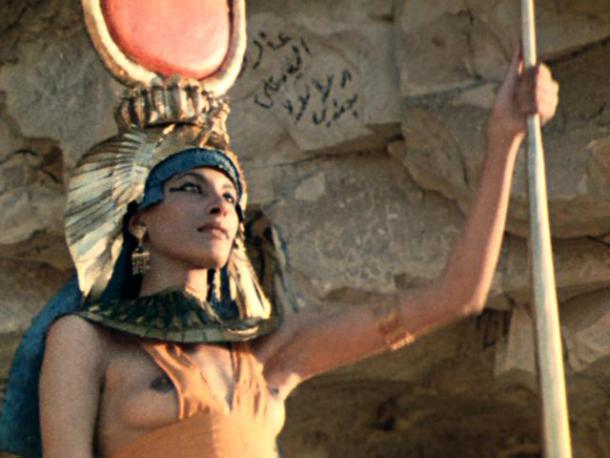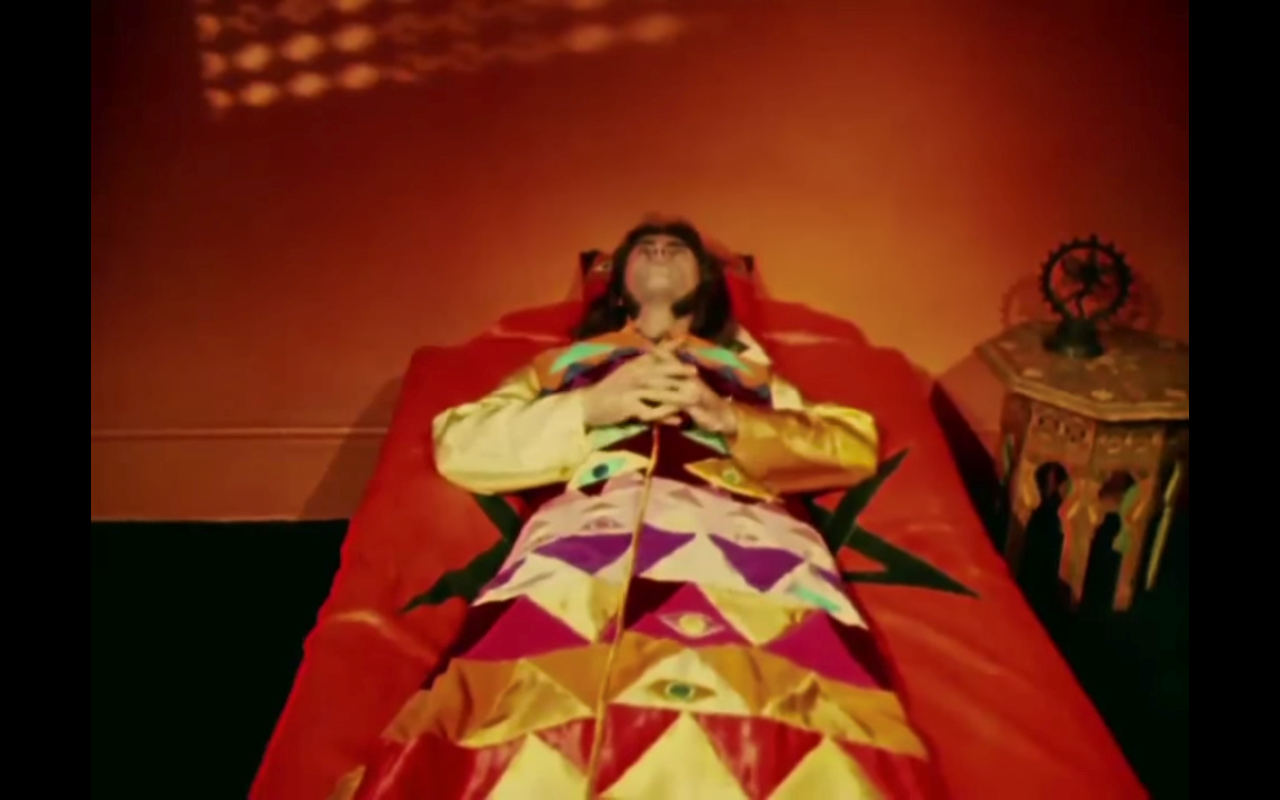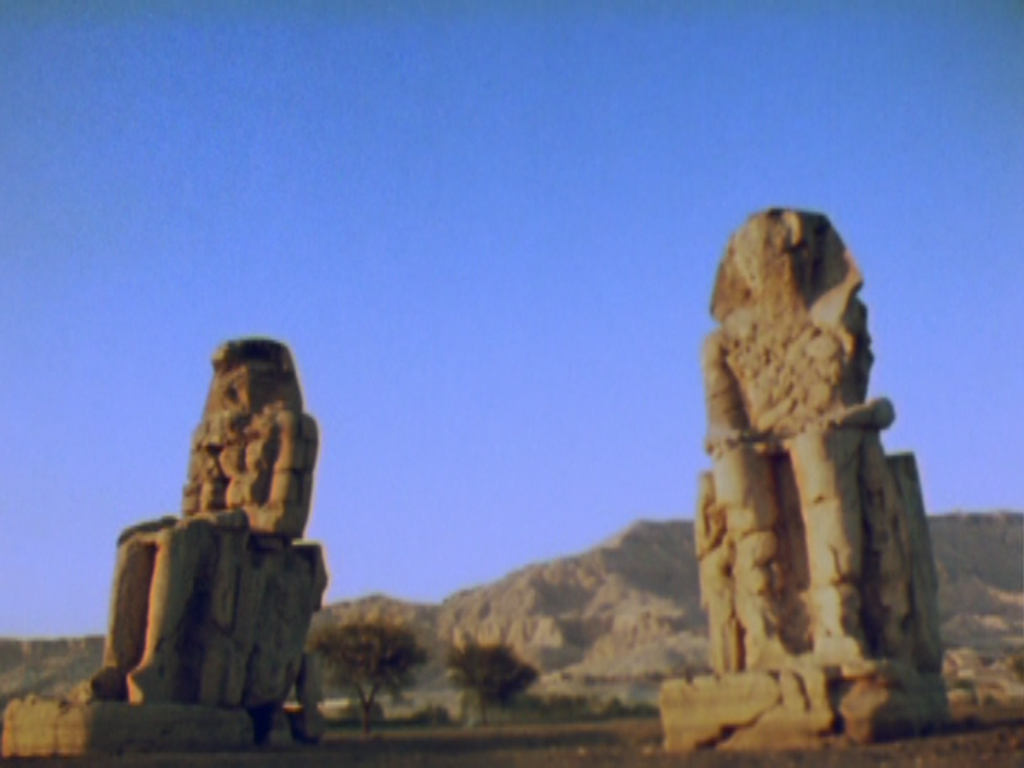
❉ Film as magical ritual, in Kenneth Anger’s ‘Lucifer Rising’.
Inspired by the magical workings of Aleister Crowley, ‘Lucifer Rising’ is easily Kenneth Anger’s masterpiece. More cinematic spell than narrative film, it’s as rich in symbolism as any hermetic tome. It can be rather impenetrable, however. Here, we’ll attempt to walk through some of its allegory.’

We open on spectacular images of erupting volcanoes, flowing lava and bubbling mud springs. These are reminders that our ancient planet is still very much alive, and as the forces of nature churn, so did Crowley combine various magical systems into his own system of Thelema.
Across millennia, forces and events align until the time is finally right call upon Lucifer to herald in the New Age, a process told through a series of awakenings, starting with the hatching of a baby crocodile from its egg, prompting mother goddess and bringer of life Isis (Myriam Gibril), to take an ankh (the key of life) and signal to her consort, death deity Osiris (Donald Cammell, who Anger cast due to his obsession with death; Cammell committed suicide in 1996) from one side of the universe to another. In the Modern era, the Magus (Hayden Couts) awakens to a sacred dawn, and, as if inspired by a dream, goes about making preparations.

He retrieves his wand from its cabinet and unwraps it. The rarely touched wand, normally locked up and kept safe is clearly a phallic symbol. He pays reverence to a statue of Horus (the Aeon of Horus is Crowley’s name for our current age), before taking his place upon a replica of King Tutankhamun’s throne. He throws a spear, another phallic symbol, which strikes a beautiful redhead seen wandering through a fertile garden. Echoing Isis and Osiris, the male Magus is the source of violence and death, the woman being the source of fertility and life, but rather than a literal act of murder, we’ve witnessed a representation of the Ceremony of Blood, and the next time we see the Magus, he’s covered in the red fluid of life.

He immerses himself in a bath over which hangs a mirror embossed with Bass & Co’s logo, along with a pyramidal trademark stamp; a playful echo of the spectacular pyramids seen in the Egypt sequences. As he closes his eyes and sinks beneath the surface, the film cuts to the awakening of Lilith (Marianne Faithfull) emerging from a stone sarcophagus to signal the commencement of spring; dressed in grey having been rejected as Lucifer’s bride, Lilith is the moon goddess and mother of demons. In a night time sequence, a group of six, torch-baring monks climb the stone steps of Externsteine, a sacred site for thousands of years (it was even used by the S.S.). Their journey is retraced by Lilith/Faithful who reaches the chapel at the summit, and as a representation of the moon goddess, pays homage to the solstice dawn, just as we see ancient Egyptians and Babylonians do in a brief montage.

There is a reoccurring motif of duality, both within the narrative and meta-fictionally, so Isis compliments Osiris because life and death cannot exist without the other; the Magus is complimented by the red headed girl who was penetrated by his phallic spear in an act of violence, but one that brings forth the blood of life; Lilith compliments Lucifer as his rejected bride because he doesn’t wish to share his power. Then, on a deeper level connecting the film’s narrative with the real world (creating a circulatory system of magic between reality and film), there’s the duality between the actors and their characters; death obsessed Cammell playing a death god, for example.

The duality given most prominence is between Faithful, whose role blurs with Lilith and herself, and Mick Jagger, who does not appear in the film but who could easily parallel Lucifer (creating yet another duality between the on-screen Lucifer (steel worker Leslie Huggins) and the off-screen Jagger); after Lucifer rises, Faithfull is seen in Anger’s apartment cradling the blood stained silk scarf Anger used to bind her wrists after she attempted suicide following her break up with the rock legend. A rejected bride in both real and symbolic.

The raising of Lucifer himself commences with the Magus banishing Chaos (painter Sir Francs Rose, of whom Cecil Beeton said, “His life story is a succession of suicides, killings and fatal accidents. In his wake he brings chaos.”). Then, in a time-lapse montage compressing the lengthy and complicated ceremony, the Magus summons the titular character in his magic circle. Lucifer looks like a biker (a common Anger motif) wearing a leather jacket emblazoned with his name in all the colours of the rainbow. But this isn’t the Christian Lucifer; this isn’t the Devil. This is the Pagan Lucifer. This is the anti-heroic trickster figure of the Gnostics. In Anger’s film, it’s made very clear that, while capable of violence and destruction, he’s not a force for evil, but a bringer of a New Age. Anger identifies as a Pagan, and Paganism is less about the conflict between good and evil, more about balancing the forces of nature. Lucifer, angel of light, doesn’t need dark Lilith, because in him, all the dualities are united.
Only with Lucifer’s arrival does Anger make a direct reference to Crowley; a banner baring a pentagram is pulled away and his image is unveiled, surrounded by a black funeral wreath.

The New Age is heralded in all locations and time periods seen in the film, revealing that Anger’s intercutting has been spatial, independent of the different time periods. All the characters in the film have been consorting together across time and space in order to bring about Lucifer’s rise. Isis and Osiris are united, and flying discs, provided by Wally Veevers of ‘2001: A Space Odessey’ fame, fill the skies of ancient Luxor and Externsteine, centuries apart, as the modern Magus triumphantly conjures lighting bolts to strike the Avebury stone circle. Mountains break through the ground. A new land usurps the old. Lucifer is bathed in a golden light and takes his place as the New Messiah.

The film’s obsession with duality is the summarised in the film’s final shot; the Colossi of Memnon; the twin statues guarding of the Valley of the Kings. In recalling Anger’s previous film, ‘Invocation of My Demon Brother’ (1969), which in itself is Lucifer Rising’s consort, this shot informs us that there’s one final duality we’ve not yet addressed…

While Crowley used women in his magical ceremonies, he was a rampant misogynist and gave them no reverence. Anger reveres his male and female deities equally. Anger is cautious of the powerful forces he stirs up. Crowley was reckless with them. Crowley lived a life of indulgence and hedonism. Anger survived the counter-culture revolution by being the calm at the eye of the storm, surrounded by (then) self-destructive people like Faithfull and Cammell, or destructive people like the film’s composer Bobby Beausoleil, who recorded the film’s score in prison.
Like the meeting of Yin and Yang, the film’s ultimate duality is between Kenneth Anger and his Demon Brother, Aleister Crowley.
❉ About the author: Jonathan Sisson studied Moving Image at the University of Central Lancashire and produced several short films. After that, he became and actor and has appeared in several film and television productions.

